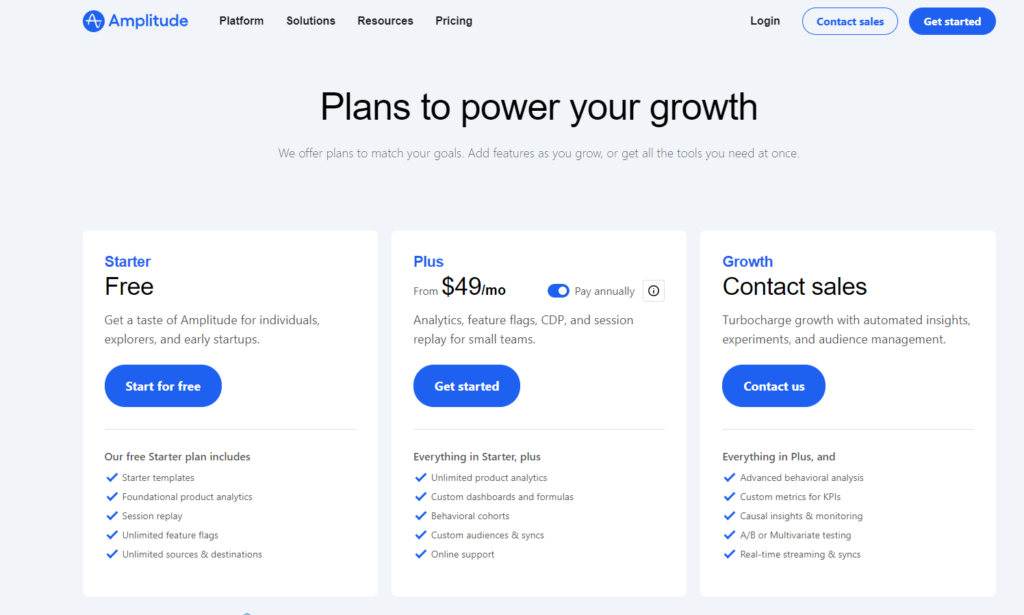In today’s fast-paced digital environment, data analytics tools are indispensable for businesses aiming to understand complex customer behaviors and refine their strategies accordingly. Among the plethora of analytics tools available, Amplitude and Looker stand out, each offering unique strengths that cater to different business needs. While Amplitude shines with its focus on product analytics and user behavior, Looker excels in creating a data exploration environment that caters to data-driven decision-making across an organization. Choosing the right tool can significantly impact your ability to harness data effectively, making it crucial to understand how each platform aligns with your specific analytics needs.
Amplitude | Looker |
|---|---|
| G2 Score – 4.5 out of 5 stars | G2 Score – 4.4 out of 5 stars |
| TrustRadius Score – 8.3/10 | TrustRadius Score – 8/10 |
User Interface and Experience
In the realm of analytics, the complexity of data does not have to equate to a complicated user experience. Both Amplitude and Looker strive to simplify data analysis, but they take different approaches to how users interact with their platforms.
Amplitude: Intuitive Design Focused on Product Teams
Amplitude is renowned for its user-friendly interface, designed with the needs of product managers and marketers in mind. The platform emphasizes simplicity and visual clarity, making it easier for teams to track user journeys, measure engagement, and understand the impact of changes within the product. Amplitude’s dashboards are highly customizable, enabling users to tailor their analytics view to their specific goals, whether it’s monitoring new feature adoption, analyzing funnel conversions, or understanding retention metrics.
One of Amplitude’s key strengths is its ability to present complex behavioral data in an accessible format, allowing teams to quickly glean insights without sifting through tables of raw data. This focus on user experience not only accelerates the onboarding process but also encourages frequent and in-depth use of the platform, fostering a culture of continuous improvement and data-driven iteration.
Looker: Deep Data Exploration for the Whole Organization
Looker takes a slightly different approach, offering a powerful platform for data exploration that caters to a wide range of users, from data analysts to business stakeholders. Its interface is built around LookML, Looker’s modeling language, which allows for the creation of detailed data models that serve as the foundation for analysis and reporting. While Looker presents a steeper learning curve than Amplitude, it rewards users with the ability to conduct deep, granular analyses and create highly detailed reports.
Looker’s dashboards and visualization tools are designed to facilitate data exploration across the organization, encouraging users to dive into data and share their findings. The platform’s emphasis on collaboration and accessibility ensures that insights are not siloed within analyst teams but are instead distributed widely, enabling data-driven decision-making at every level of the organization.
Data Visualization and Reporting
In the digital era, where data is plentiful but insights are gold, the ability of an analytics tool to present data in an understandable and actionable format is paramount. Both Amplitude and Looker offer robust solutions, but their approaches to data visualization and reporting cater to different needs and preferences.
Amplitude: User Journey Visualization
Amplitude excels in visualizing complex user behaviors and journeys across platforms, making it invaluable for product teams and marketers focused on user engagement and retention. Its strength lies in offering dynamic, real-time dashboards that can be customized to track specific metrics or events critical to understanding user interactions. Amplitude’s visualization tools are designed to be intuitive, allowing users to easily navigate through layers of data to uncover patterns or anomalies without extensive technical expertise.
The platform’s reporting features are similarly user-friendly, emphasizing flexibility and depth. Users can create detailed reports that drill down into specific aspects of the user experience, enabling targeted insights that can drive product improvements or marketing strategies. Amplitude’s focus on behavioral analytics ensures that its visualization and reporting tools are particularly well-suited to businesses looking to deeply understand how users interact with their digital products.
Looker: Comprehensive Data Exploration
Looker, on the other hand, takes a broad approach to data visualization and reporting, emphasizing comprehensive data exploration and analysis across all areas of a business. Its platform is built around the concept of LookML, a powerful modeling language that allows for the creation of highly detailed and interactive visualizations and reports. This flexibility makes Looker an excellent choice for organizations with diverse data needs that span beyond user behavior analysis, including sales, marketing, operations, and more.
Looker’s strength is in its ability to handle large datasets and complex queries, presenting results in clear, compelling visualizations that can be shared across teams or embedded in websites and apps. Its dashboards and reports are highly customizable, supporting a wide range of charts, graphs, and tables designed to make even the most complex data sets understandable and actionable.

Related: Check out our free SEO suite

Collaboration and Sharing Capabilities
Effective collaboration tools and easy sharing options can significantly enhance the value of analytics platforms by ensuring that insights are readily accessible and actionable across teams, departments, and even with external stakeholders.
Amplitude: Facilitating Team Insights and Actions
Amplitude recognizes the importance of team collaboration in leveraging analytics to drive product and marketing strategies. It offers features designed to facilitate teamwork, such as shared dashboards and reports that can be easily accessed by multiple team members. This ensures that everyone is on the same page, working towards common goals with a unified understanding of user behavior and product performance.
Moreover, Amplitude’s platform supports annotations and notes within the data visualization interface, allowing team members to highlight observations, ask questions, or suggest actions directly within the context of the data. This feature encourages active engagement with the analytics and fosters a culture of data-driven collaboration.
Looker: Empowering Data-Driven Organizations
Looker takes collaboration and sharing a step further by embedding these capabilities into the core of its platform. With its powerful data modeling language, LookML, Looker enables the creation of centralized data models that serve as a single source of truth for the entire organization. This approach not only standardizes data analysis across teams but also facilitates deeper collaboration on data exploration and insight generation.
Looker’s sharing capabilities are extensive, including the ability to share visualizations and reports via email, embed them into websites or applications, and even schedule regular report deliveries to ensure stakeholders receive timely updates. Looker’s emphasis on accessibility and transparency makes it an ideal tool for organizations that prioritize data democratization and collaborative decision-making.
Integration Capabilities: The Art of Ecosystem Synergy
The digital age requires tools not just to function in isolation but to act as part of a cohesive ecosystem, enhancing and being enhanced by other tools within the tech stack. Here’s how Amplitude and Looker fare in this critical arena.
Amplitude: The Connective Hub
Amplitude is designed with the modern tech stack in mind, offering robust integration capabilities that allow it to seamlessly connect with a myriad of tools across marketing, product development, data management, and more. Whether it’s pulling in data from CRMs to enrich user profiles or pushing insights to marketing automation platforms to personalize campaigns, Amplitude acts as a central hub, ensuring data flows freely and insights are actionable across the board.
What sets Amplitude apart is not just the breadth of its integrations but the depth. It allows for detailed event data to be imported and exported, enabling teams across the organization to leverage rich, user-level insights in their respective tools, from A/B testing platforms to communication channels like Slack, enhancing decision-making at every turn.
Looker: The Strategic Integrator
Looker takes a strategic approach to integration, focusing on creating a unified source of truth that can serve the entire organization. Through its powerful LookML modeling layer, Looker facilitates deep integrations with databases and business intelligence tools, ensuring that all data analyzed is accurate, up-to-date, and consistent across applications.
The strength of Looker’s integrations lies in its ability to not just share data but to transform it into actionable insights that can be accessed directly within other business tools. From integrating with marketing platforms to enhance campaign targeting based on user behavior insights, to embedding analytics directly into operational tools, Looker ensures that data is not just integrated but is inherently actionable across the tech ecosystem.
User Accessibility and Learning Curve: Empowering Users at Every Level
The ease with which teams can adopt and effectively use an analytics tool is critical for its success within an organization. Let’s delve into how Amplitude and Looker accommodate users of varying technical abilities and facilitate their journey towards mastering the platforms.
Amplitude: User-Friendly Yet Powerful
Amplitude is celebrated for its user-friendly interface, which manages to simplify complex data analysis without compromising on depth. New users can navigate the platform with relative ease, thanks to intuitive design choices that make even sophisticated analytics features accessible. Amplitude also offers extensive documentation, tutorials, and a community forum to help users ramp up their skills and make the most of the platform’s capabilities.
Despite its approachable design, Amplitude packs a powerful punch in terms of analytics depth, meaning that as users become more familiar with the platform, they can delve into increasingly complex analyses. This balance between accessibility and power makes Amplitude a versatile choice, catering to teams with a range of technical backgrounds and analytics needs.
Looker: Steep Learning Curve, Rewarding Mastery
Looker, with its powerful and flexible modeling language (LookML), offers a rich environment for data exploration and analysis. This flexibility, however, comes with a steeper learning curve, particularly for users not familiar with SQL or data modeling concepts. That said, for those willing to climb this curve, Looker opens up a world of deep, customizable analytics that can precisely fit an organization’s needs.
Looker supports its users with comprehensive documentation, a robust learning platform (Looker University), and an active user community. These resources are invaluable for new users and for those looking to deepen their expertise. For organizations that can invest the time in mastering Looker, the platform offers unparalleled depth and customization in analytics.
Pricing
Amplitude:

Looker:

Conclusion
In our comprehensive journey through the capabilities and nuances of Amplitude and Looker, we’ve uncovered key distinctions that set these platforms apart in the analytics landscape.
Amplitude shines with its user-friendly interface and powerful analytics capabilities, making it an excellent choice for businesses seeking to understand and enhance user experiences with minimal onboarding time. Its focus on user behavior analysis, combined with extensive integration options, ensures that businesses can leverage deep insights across their tech stack, making Amplitude ideal for product teams and marketers alike.
Looker, on the other hand, stands out for its robust, customizable analytics environment, powered by LookML. It caters to organizations ready to invest in learning and customization to achieve precise, in-depth insights tailored to specific business questions. With its strategic approach to integrations and a strong emphasis on creating a unified source of truth, Looker is particularly suited for businesses prioritizing comprehensive data analysis across multiple departments.
Read Next:
- GetResponse vs Zoho Campaigns: The Best Email Marketing Tool for 2024
- AWeber vs ActiveCampaign: The Best Email Marketing Tool
- Constant Contact vs Campaigner: Best Email Marketing Tool
- GetResponse vs Omnisend: The Best Email Marketing Tool for 2024
- AWeber vs Benchmark Email: The Best Email Marketing Tool





















